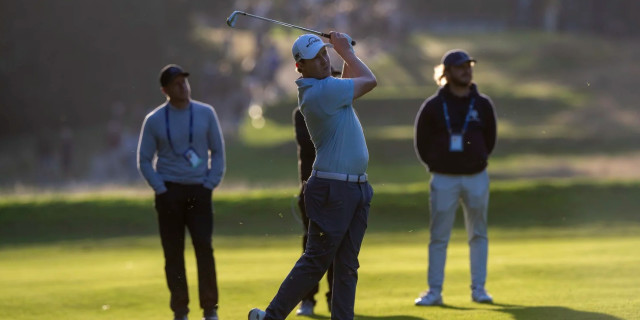
Why Jack Nicklaus May Be the Best Links Golfer in History
The links courses of Britain and Ireland are the cradle of the game. George Peper and Malcolm Campbell’s beautifully presented book ‘True Links’ identities only 246 layouts on the planet befitting that status, a minuscule number within the catalogue of the 34,000 that are reported to exist worldwide.
That rarity makes the challenge of golf’s purest form unique and compelling to watch and play. Rather than solely being a test of execution – discovering who can best join the dots from A to B - the questions asked on a links are distinct and not commonly examined elsewhere. Battling the changeable elements of the seaside is just part of that. Creativity. Imagination. Shot making. Choosing between alternative routes. Making the ground your friend.
Some are not made for such complexity. It’s not easy, but this game was never created to provide instant gratification. The Scottish-born American journalist James Reston wrote (ironically, we think) that golf was a “plague invented by the Calvinistic Scots as a punishment for man’s sins.”
But for those who open their minds and embrace the intricacies, the rewards are boundless.
This preamble raises the topic of who is the greatest links player in history? Logic would dictate that the most straightforward way to answer that is to study the names on the Claret Jug – The Open Championship being the ultimate trial of links golf.

Looking at the famous Golf Champion Trophy – to give the jug its official moniker - you see the name of Harry Vardon engraved six times, James Braid and John Henry Taylor five times; a total later matched post World War II by Peter Thomson and Tom Watson. Those immortalised trailblazers of the 1860s and 1870s, Old and Young Tom Morris, and Willie Park Sr were four-time winners. Walter Hagen – the first American born champion – and the great South African Bobby Locke also secured a quartet of titles.
Vardon, Braid and Taylor dominated the Open between 1894 and 1914. Comparing eras literally spanning centuries is an impossible and nonsensical task – the game they played was even unrecognisable to that showcased in the days of Ben Hogan or Sam Snead, never mind the scientific and technologically advanced version of golf that we see now. But just spend an hour in the British Golf Museum in St Andrews – look at the clubs and balls that were used back then – and you develop an instant admiration for the scores that were shot around the turn of the 20th century.
The Great Triumvirate may have been the most purely skilled players in history.
Bobby Jones – the greatest of all amateur golfers – played in four Open Championships, winning three of them (we’ll ignore his ignominious debut at St Andrews) and the 1930 Amateur on the Old Course. The American’s rich experiences in the British Isles formed his outlook on the game.
The dashing Englishman Henry Cotton mustn’t be neglected in this conversation. He secured a trio of titles highlighted within a staggering 17 top ten finishes across 31 years. And don’t forget that the Open was on hiatus for several of his peak seasons during wartime. The maestro could play.
But what of Thomson, the legendary Australian who sadly passed away in 2018. His impressive technique and noted intellect were ideal for the rigours of the coastline. For seven years during the 1950s, Thomson either won or finished runner-up in the Open, making that ambitious journey from his Melbourne home. This run included a hat-trick of victories in 1954, ’55 and ’56. It was remarkable.
Some have spuriously attempted to dampen the enormity of Thomson’s achievements due to the relative lack of American golfers in the fields at that time. Apparently, there are no other great players internationally. But Thomson later shut down that critique – not that he needed to – by securing his fifth title at Royal Birkdale in 1965 ahead of the U.S. stars that had now reembraced the Open.
Speaking of those from across the Atlantic with an affection for these courses, Tom Watson boasts a formidable argument to be declared the greatest exponent of the original game. Winning five championships in nine attempts – despite an early dislike for links – between 1975 and 1983. He was runner-up at St Andrews in 1984 but did not replicate that past success until his extraordinary performance at Turnberry in 2009, finishing an agonising second months before his 60th birthday. The man from Kansas City became the oldest player to make the cut in 2011, beating his own record in both 2012 and 2014. Those three Senior Opens were fine additions to the CV too.
It’s hard to argue with any of these men standing as the greatest, but were they actually the best?
Maybe the solution is far more straightforward. Jack Nicklaus – the game’s most exceptional major champion – has been staring at us in the face this whole time. We just haven’t been paying attention.
The Golden Bear’s introduction to links golf came as an unbeaten member of the U.S. Walker Cup team at Muirfield in 1959. Weeks later, he lost in the quarterfinals of the Amateur at Royal St. George's. It was the beginning of a mutually appreciative relationship.
Making his Open debut in 1962, Nicklaus was weeks removed from winning his first professional major in a playoff over the charismatic Arnold Palmer in a playoff at Oakmont, denying the American icon victory in his home state of Pennsylvania. Revenge came swiftly at Troon when successfully defending the Claret Jug, Palmer finished an eye-watering 29 strokes ahead of Nicklaus.
Needless to say, that was the first and last time that Palmer beat Nicklaus in an Open Championship.
The younger man found an appreciative audience in Britain that he didn’t enjoy during those early days at home from the impassioned Arnie’s Army, outraged by the stoic and stocky blonde-haired kid who had mercilessly grasped the crown from their hero.
In his featured episode of the wonderful Chronicles of a Champion Golfer series, Nicklaus said of the spectators at the Open: “I always felt in Britain, and particularly Scotland, that I was one of them. They weren’t interested whether I danced around the green, or whether I threw my cap. They were more interested in golf. And my interest in the game that they loved. In other parts of the world, they are more interested in the star power than the actual sport. But when you play in Britain, they’re into golf, they’re into the game.”
Palmer’s long-time friend and IMG publicist, Bev Norwood noted in Ian O’Connor’s book Arnie & Jack, that “the British Open was the one place where Jack ended up getting more love than Arnold.”
But Jack was rather good at it too.
Third place in 1963 at Lytham – missing by one shot to make it a three-man playoff with Bob Charles and Phil Rodgers – was the start of things to come. Faced with difficult conditions over the first two rounds, Nicklaus then produced stunning scores of 66 and 68 to finish second behind Tony Lema at St Andrews. Two years later, the Ohioan finally clasped his hands on the Claret Jug at Muirfield, completing the career Grand Slam at just 26. He defied those naysayers who said he couldn’t succeed in the wind. The floodgates had opened.
For 13 of the next 14 years, Jack Nicklaus finished inside the top five of the Open Championship. He was a measly sixth in 1969. There were the two victories at St Andrews - 1970 and 1978 – and the second places in 1967, 1968, 1972, 1976, 1977 and 1979. His denials by Lee Trevino and Watson, famously in the Duel in the Sun, are the most notable of these losses.
He was runner-up in the Open on seven occasions – a record that is almost certainly never to be matched. That doesn’t include the aforementioned near-miss in ’63 or the third place at Carnoustie 1975 when he finished one shot outside the playoff between Watson and Australia’s Jack Newton. Nicklaus’s 16 TOP FIVES (18 top ten finishes in total) are also unassailable records. His 33 rounds in the 60s (the last of which was a 66 at Lytham aged 56) also stands as a record.
This represents unfathomable consistency in the face of time and the vagaries of the weather. Year in, year out. Mentally, it’s a psychological marvel.
To put that into some context, Tom Watson had eight top fives in the Open, Nick Faldo eight, Gary Player six, Tiger Woods six, and Seve Ballesteros four. Simply put, no one in living memory gave themselves the opportunity to win more Opens than Jack Nicklaus.
“I could have won another two or three Open Championships very easily with the right break but didn’t quite get it. Disappointing, yes. But you start out a field with 150 players, you’ve got to beat them all if you’re going to win.”
Between 1966 and 1980, the only players who can claim to have beaten Jack in the Open are: Roberto De Vicenzo, Gary Player, Tony Jacklin, Bob Charles, Peter Thomson, Christy O'Connor Snr, Lee Trevino, Lu Liang-Huan, Craig Defoy, Tom Weiskopf, Neil Coles, Johnny Miller, Peter Oosterhuis, Tom Watson, Jack Newton, Seve Ballesteros and Ben Crenshaw.
But why was Jack Nicklaus such an effective links player? The key word is adaptability. Being a cerebral strategist, the best driver of your generation, and one of the finest iron players ever didn’t hurt either.
In Chronicles, he engagingly describes: “I loved the Open Championship. Playing in cooler weather, change of conditions, different types of golf course, different atmosphere, different gallery, different clubs, different ball, different everything than I was normally used to. And I loved all the changes.
“Lot of the players didn’t like all that change. I see players come to a tournament and say, ‘this golf course doesn’t fit my game’, HELLO? The golf course isn’t supposed to it your game. You are supposed to fit your game to the golf course. That was the fun of it. Learning how to do that.”
It’s not a stretch to conclude that no one has been more successful at moulding their own game to the specific challenges of golf course as well as the 18-time major champion did. The golfing chameleon. That’s how he mastered these rugged links of the British Isles.
Ultimately, Harry Vardon, James Braid, Peter Thomson and Tom Watson will be considered the greatest Open champions. Take your pick. Deservedly so. You can’t argue with the titles. But was Jack Nicklaus consistently the better links golfer for longer? That’s a question for many a debate.

The oldest & most prestigious major, a trip to The Open is a must for every golf fan. From tickets and transfers to hospitality & golf, Golfbreaks.com can build the perfect package to help you experience The Open in style.
Tags: The Open Links Golf jack Nicklaus









